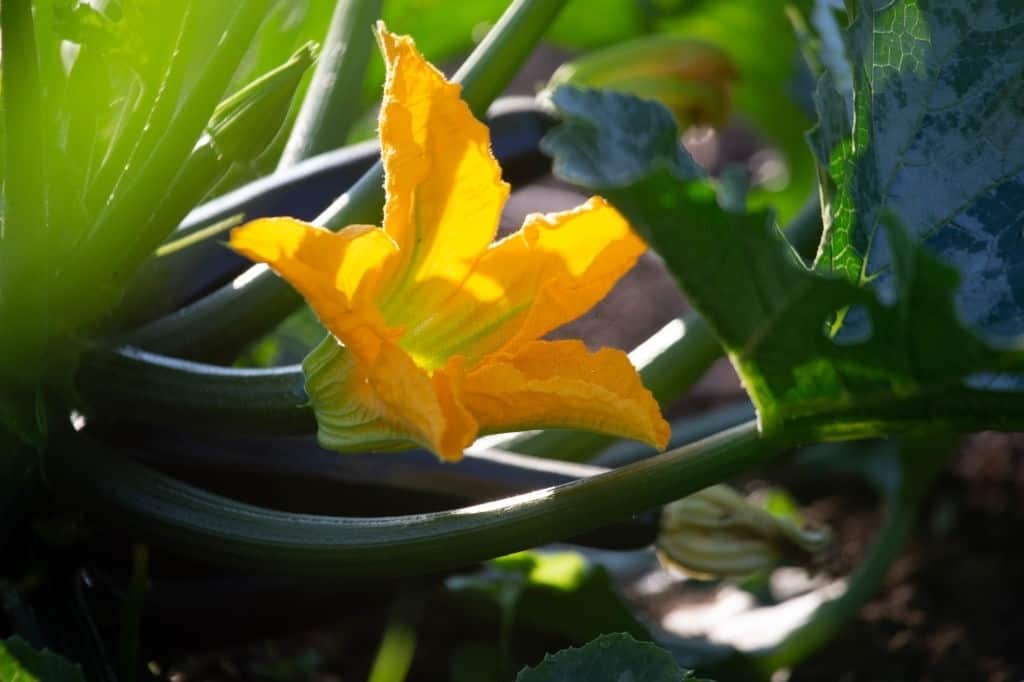Zucchinis blossom beautifully when taken cared for well, but even when you do so, you might have noticed that those blossoms would fall off at times. And unfortunately, they fall off without bearing fruit, and if they do develop, it ends up rotting away. It gets frustrating being left with just one or two zucchinis each plant, no matter how hard you try to care for it.
Don’t worry, you’re doing everything right. It might not be your fault, but by the bees (or lack of it!). Without proper pollination be bees and helpful insects, it ends up with your plants not flowering well, or none at all.
That’s why it’s important to learn how to pollinate zucchini without bees in case of a bee shortage from the weather or certain conditions. But what can you do to hand pollinate your zucchini plants successfully? Read on to find out!

How to Pollinate Zucchini Without Bees
Vegetable crops that produce fruit, like zucchini, require pollination to develop fruit for harvesting. Pollination happens when pollen from the flower’s male sexual organ (the stamen) comes into contact with the female sexual organ (the stigma).
There are self-pollinators like tomatoes and peas, which have male and female parts on one flower. Wind and insects would dislodge the pollen, leading to fertilization in the flower.
But with other vegetable crops that produce separate male and female flowers, pollination happens when insects like bees and hoverflies would visit the flowers, collecting nectar and pollen. Then, the pollen will be rubbed on the insect and rubbed off to the next flower insects would visit. After that, the fruit would develop when the male pollen was transferred to female flowers of a similar species.
There are also other ways to pollinate vegetable crops, such as corn, which is pollinated by wind.
When your plant isn’t pollinated, then chances are that your zucchini plant flowers won’t bloom properly, no matter how well you take care of it and give its necessary resources. Fortunately, it’s easy to pollinate vegetable crops on your own, and by hand! Here are the easy tips you can follow:
1. Just Use Your Hand
With this method, begin early in the morning, this is when pollen is most available. They usually close by afternoon, which is why you need to time pollination in the morning.
Look for the freshly opened male and female flowers, with male flowers having short stems and female flowers having longer stems and a zucchini-shape at its base.
Clip off the male flower, removing its petals, exposing its pollen-heavy anther. Then, touch, rub or roll the male flower’s pollen to the stigma, located at the center of your female flower. Repeat this process on the other freshly opened flowers and within a few days, you’ll bear more flowers and fruit.
2. Use a Q-Tip or Brush
You can also use a Q-tip or small artist’s paintbrush. Rather than plucking off the male flower, simply gather all the pollen you can get from a freshly opened male flower with the clean and unused Q-tip or paintbrush. You can find sticky yellow pollen, which will stick easily on the Q-tip or brush.
Afterward, find the female bloom and look inside it to locate its stamen. You’ll see this sticky pad on the slender stem, right in the center of the female flower. Once located, brush the pollen from your Q-tip or paintbrush into the stamen, which would be easy as the sticky surface will attract the pollen.
Repeat with all freshly opened blooms. Note that pollen from one male flower can be used on multiple female blooms. Once you run out of pollen on your Q-tip or paintbrush, you can gather more pollen from other male flowers if required.
Bonus tip: Make sure you do this gently and avoid damaging the male or female flowers! If damaged, the male flowers may stop producing pollen and female flowers end up not being able to produce fruit successfully.
3. Encourage Other Insects to Pollinate
It isn’t only bees that have the ability to pollinate your plants! There are other beneficial insects as well. You can encourage insects to visit the garden by planting various flowers that are known the attract good insects. That way, while the insects gather nectar and pollen from flowers you plant, they’ll also pollinate the zucchini plants along the way.
I recommend planting flowers such as comfrey, geranium, lavender, sunflower, or borage.
You will know if any of these methods work after a few days and you see your plants producing fruit, which becomes bigger and green. Also, after pollination, the female flowers will close up, remaining closed for one to two days. You know you have succeeded in hand pollination when the flower wilts and falls, but the fruit remains on the stem, growing well.
Harvest the fruit once it reaches three to six inches and repeat the pollination process when necessary. Congratulations!
However, if you still don’t find any results, you may want to look into the other causes of why your plants aren’t bearing fruit successfully.
Do you want to learn more about how to pollinate zucchini without bees? Then check out this informative video:
Wrapping It Up
While it’s better to have bees around to help pollinate your zucchinis, it’s still possible to hand pollinate them yourself. If ever push comes to shove and beneficial are unable to go around your garden to pollinate, you can try any of the tups I mentioned above. These will help your zucchini plants continue to flower and produce fruit for your consumption and enjoyment.
I hope that this article on how to pollinate zucchini without bees helped you out! So don’t wait any longer and try any of these tips to save your zucchini and achieve bountiful fruit this harvesting season. Good luck!